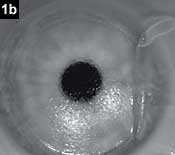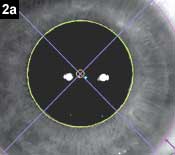Automated alignment method eclipses manual marking of astigmatic eyes
Some of the benefits of iris registration include shorter procedure time and a lower re-treatment rate, surgeon says.
Refractive surgeons realized early on that proper alignment was important for astigmatic ablations. Many surgeons aligned the head the best they could, in hopes the eye would follow. Marking the eye with ink was adopted for its relative ease, low cost and understandable mechanism of action. Marking with ink has some limitations. The ink may disappear before alignment during surgery, anxious patients find the marking processes disturbing, the method allows for human error and it is time-consuming.
Despite its limitations, manual marking has proved to yield better results than not marking. Edward E. Manche, MD, of Stanford University demonstrated the importance of marking astigmatic patients. He published a paper that demonstrated improved results when marking eyes that had 0.75 D or more of cylinder. In 2003, VISX CustomVue treatments became available, and our practice quickly adopted this treatment for any patient who was within the approved parameters. The complex design of custom ablation patterns further increased the need for ensuring alignment and centration.
My initial marking method began by having the patient sit or stand in front of me. Then I instructed him to close his eyes and orient his head to what felt level. After opening his eyes, I manually covered one eye of the patient. I then closed my eye that was opposite to the patient’s covered eye, so that I was looking at the patient open eye to open eye. The 3 and 9 o’clock positions were then marked. Because of cyclotorsional issues and because we treat monocularly, I felt it was important to test the patient and mark him in a monocular fashion. In an attempt to improve accuracy, I began using the slit lamp with a horizontal slit oriented straight through the center of the pupil. The patient was instructed to fixate on the center of the beam while I placed the marks.
Whether we use the slit lamp technique or the first method, we then had the patient re-orient himself away from the slit lamp, face to face with the surgeon, as described above. A line level was then oriented along the axis of the marks to estimate if they were horizontal. If necessary, additional marks were added until two marks could be connected and appeared level.
Iris registration
We began using iris registration (IR) as soon as it was available in 2005. In our initial patients we continued to mark the eyes to double-check its accuracy because we were not certain the IR would routinely work. Once confident in the accuracy and reliability of IR, we abandoned marking.
|
|
|
Images: Stratas BA |
Distinguishing the outcomes
When comparing IR and manual marking, I have found that IR decreases procedure time. In my experience with IR in bilateral VISX CustomVue Intra-LASIK, it is usually 11 minutes from when the patient enters the room until he leaves the room. Marking the eye creates an extra step, which takes more time. Marking is done just before the patient goes into the LASIK room; however, this step eats up more physician time because you need to go through the process of switching rooms and re-orienting the patient.
In addition, IR helps to increase our patients’ confidence and diminish their anxiety.
Each VISX CustomVue treatment automatically comes with IR. And because we do 98% or more custom treatment, we just leave the tracker in the IR mode all day. It probably gives us back 8 to 12 minutes per hour on LASIK.
IR appears to have lowered our re-treatment rate. That may be due to the fact that IR performs two significant functions: It takes into account cyclorotation, and it adjusts for any centroid shift. Centroid shift can occur when the pupil at surgery is disparate in size compared with the pupil on the WaveScan image. Together these functions ensure that the treatment goes exactly where it was measured. Currently, our re-treatment rate for CustomVue IntraLASIK patients appears to be about 1.8%. Patients like meeting their goals with just one procedure. It saves the patient time and money in the long run if additional treatments are not required.
For more information:
- Byron A. Stratas, MD, FACS, can be reached at 1729 New Hanover Medical Park Drive, Wilmington, NC 28403; 910-763-3601, ext. 222; e-mail: bstratas@wilmingtoneye.com. Dr. Stratas does not have any financial interest in any of the products mentioned, nor is he a paid consultant.
- Advanced Medical Optics, manufacturers of the VISX CustomVue and the STAAR S4 IR Laser System,can be reached at 1700 E. St. Andrew Place, Santa Ana, CA 92799; 714-247-8200; Web site: www.amo-inc.com.




